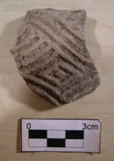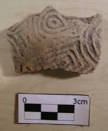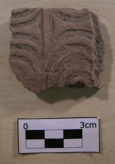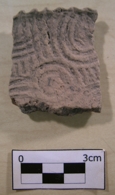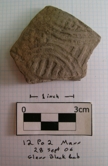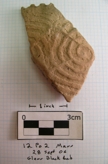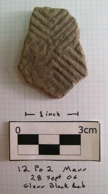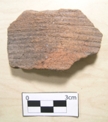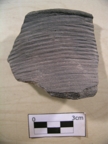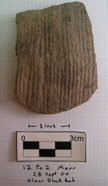Evidence for Interaction
During the Leake Site investigation, Principal Investigators Scot Keith and Dean Wood took a trip to Indiana in order to conduct research into the Mann site, a Middle Woodland Hopewell site located in southwestern Indiana (Figure 1). This site is notable due to the presence (and abundance) of Swift Creek complicated stamped pottery, as well as sand tempered simple stamped wares very similar to Cartersville simple stamped pottery. The site has long been known to contain Swift Creek type pottery, recognized by such archaeologists as James Kellar and Bret Ruby. As the Swift Creek complicated stamped pottery tradition is a Southern manifestation and not endemic to that region, its presence at Mann indicates a connection between Swift Creek and Midwestern Hopewellian peoples. Our research was designed to investigate this connection.

Figure 1. Location of the Mann and Leake sites.
We examined the Mann site collections held at the Glenn A. Black Laboratory of Archaeology at Indiana University in Bloomington and the private collection owned by Charles Lacer in Evansville. We took with us photographs of several hundred Swift Creek sherds from Leake in order to search for potential design matches with the examples from Mann. While no exact design matches were found, we did come away with several interesting observations. Many of the complicated stamped design elements are shared between the sites, yet one design common at Leake - the barred oval - is rare at Mann. Furthermore, we noted numerous examples of the zigzagged Crooked River design at Mann, which is common in the Gulf Coastal and southwestern Georgia region, and conversely absent at Leake. An early Swift Creek pottery rim trait - deep and closely spaced rounded notches (often referred to as notched or scalloped) - is very common for the complicated stamped rim sherds from Mann (Figure 2), and this rim form is found at Leake as well.
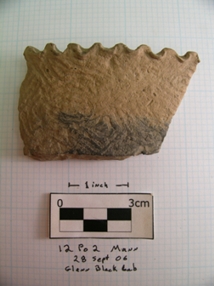
Figure 2. Swift Creek notched rim sherd from the Mann site.
As documented by Bret Ruby and Christine Shriner (see here), the Swift Creek complicated stamped wares from Mann are produced using a grog/clay tempered paste, while the simple stamped wares are sand tempered. Petrographic analysis conducted on the Mann site sherds indicates that the complicated stamped wares are produced locally, while the simple stamped wares are non-local, the materials suggesting a Southeastern origin. While assembling Leake sherds for a petrographic study conducted by Jim Stoltman shortly after returning from this research trip, Mr. Keith noted a complicated stamped notched rim sherd which was extremely similar to the Mann site examples, particularly in terms of paste temper and texture (Figure 3). This sherd was submitted for petrographic analysis in order to see if it was indeed petrographically similar to those from Mann. Sure enough, the results revealed that it was made using a similar paste, thereby providing a direct connection between these two sites! In addition, a small rocker stamped rim sherd we recovered from Leake was made using this Mann area paste as well.

Figure 3. Leake site Swift Creek sherd - produced at the Mann site?
Another ceramic variety recovered from the Mann site is shown in Figure 4, consisting of diamond shaped checks, each with a raised square or circle within. This rare pottery type has only been found at sites displaying Hopewellian connections, both in the Midwest and the Southeast. In addition to Leake, they have been found in Ohio (Seip, Rockhold, Harness, and Turner), Georgia (Miner's Creek, Butler Creek, Shoal Creek, and Mandeville), Tennessee (Yearwood), North Carolina (Biltmore Mounds), and Florida (Bird Hammock). Their restriction to these important Hopewellian sites suggests they were used for a narrow range of activities, most likely in ceremonial contexts.
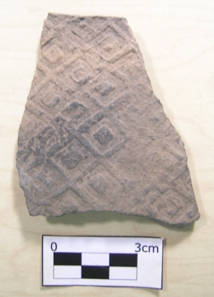
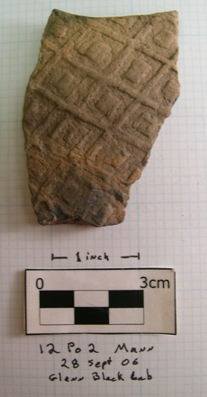
Figure 4. Diamond/dot stamped sherds from the Mann site.
In addition to the ceramic similarities, we noted the presence of the lithic material Tallahatta Quartzite (TQ) within the Mann assemblage (Figure 5). This material outcrops along the Gulf Coastal Plain, primarily in Florida and Alabama, yet also within portions of Georgia and Mississippi. TQ is mapped geologically within Georgia along the Chattahoochee River in Early County, just west-southwest of Kolomoki Mounds, another significant Middle Woodland mound center. Several specimens of TQ were recovered from the Leake excavations, and were also identified at Kolomoki, an important Middle - Late Woodland mound site in southwest Georgia.
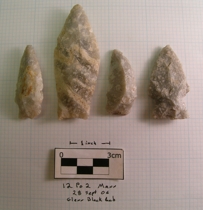
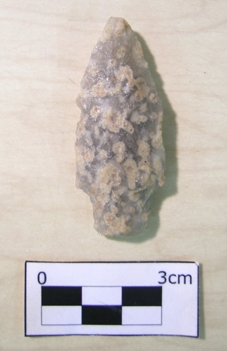
Figure 5. Mann site artifacts of Tallahatta Quartzite.
Another artifact type that is found at Hopewellian sites like Leake and Mann is ceramic human figurines. The similarity between these examples from the Mandeville site in southwest Georgia (Figure 5) and the Mann site (Figure 6) is striking. Numerous figurine fragments were recovered from Leake, including two faces (Figure 7).
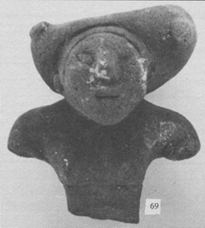
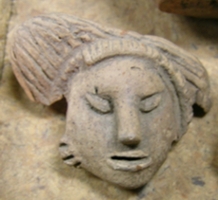
Figure 5. Mandeville figurine. Figure 6. Mann figurine.

